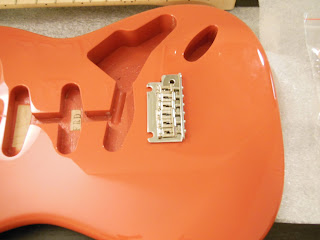I finally got some more parts earlier in the week.
Bridge tremolo parts:
Clockwise from top: tremolo bushings, tremolo pivot posts, tremolo spring claw, springs, spring claw screws (actually neck screws but they can be used for the claw).
Sorry for the blurry shots. I'm going to get a tripod soon for better shots and also so I can take better video of me doing some of the work. I also didn't take anything out of the bags yet because I know I'm going to be playing with the parts when I get bored, and I know that's a great way to misplace them.
What I'll need to do is to drill 2 3/8 inch holes into the body, and then press the bushings in. Afterwards, I can screw the posts in and then put the bridge assembly on. The claw, springs, and screws will anchor in the back of the body and keep tension on the bridge. When I get to installing it, I'll show each different part in more detail.
I'm trying to think about how I'm going to determine where to drill the holes, and I've got a couple of ideas. I think I'll measure the neck and body in a couple of different places and then establish some center lines on some masking tape. Once I've done that, I can align the neck and body using the center lines so that the neck fit will be good. I do have the tremolo routing template from StewMac, and I can use the center lines in the template to find where I need to drill. I can use this to check against the neck/body center line method as well. The annoying thing about the 2 pieces (neck, body, bridge) is that I sort of need the neck and body to get the bridge distance from the neck to be correct, but I need the bridge and body to align the neck to be straight, and I need the bridge and neck to ensure my drill holes are in the right place. I'm a software engineer, and this is why I hate circular dependencies. I'll need a lot of masking tape, measuring, squaring, and clamping to get the tremolo installation just right.
Moving on...
Plastic and mounting parts:
Clockwise from left: white Stratocaster pickguard (3-ply, white-black-white, non-aged white color), white switch tip, white volume and tone knobs, strap buttons and screws, pickup height tubing, pickup and switch screws.
I wanted straight white since I think the aged white look would be a bit weird on what will essentially be a modern-style Stratocaster. I want to reserve the vintage look in a future build. The volume and tone knobs do look slightly off-white even though the part number seems to indicate its the straight white color. It's still a pleasant look, however:
Finally, the electronics parts (and the neck plate + screws):
Clockwise from top: output jack plate, output jack, no-load tone pot, 0.022 μF Orange Drop capacitor (purdy!), grounding lug, blank neck plate and screws.
The no-load tone pot goes from 0-9 (the knobs start from 1, but I count from 0), and after a click, at 10, lets the full signal through. I intend to wire the far tone pot to affect both the middle and bridge pickups, but I want an option to be able to play the bridge pickup without any tone control on it. Traditional Stratocaster wiring has the first tone knob affecting the neck, the second tone affecting the middle, and nothing affecting the bridge. Coming from humbuckers, I prefer a slightly mellower sound and I want to be able to roll off the treble on the bridge pickup (the brightest sounding one) to be able to find a wider range of tones. At the same time, I want to be able to take the tone control out and get the traditional tone as well.
I did some more sanding of the bridge pocket over the weekend, and I still have a bit more left to be able to get the neck to fit properly. I'm working very slowly to minimize mistakes. I'm probably not going to do anything after the sanding for a while, because although I've gotten most of the mounting parts for the things I want to do next (neck attachment and tremolo bridge installation), I forgot 1 crucial component, which is lubrication for the screws. I know I can use soap to lube the screws (to prevent anything like breaking them inside the wood while I'm cutting threads, etc) but I happen to really hate the smell of soap along with wood. I'm getting a batch of special screw wax delivered to me, but it might take a week. For now, I'm going to sit tight and order any other parts I need slowly.























